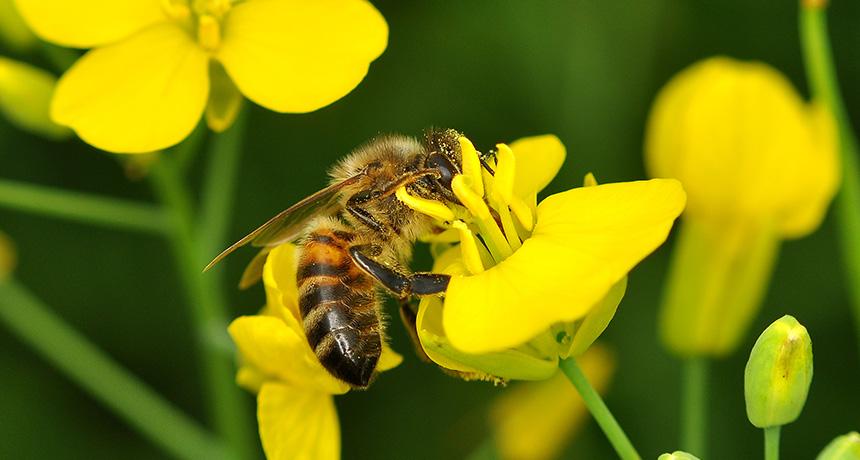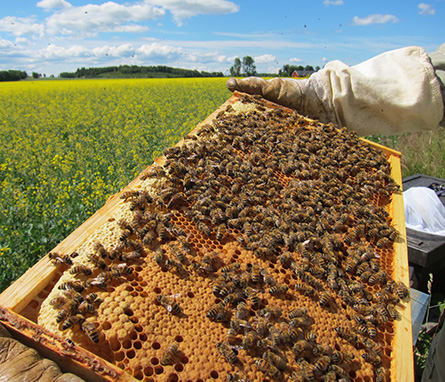Pesticides offer bees a risky allure
Tests show some pollinators can’t taste certain widely used pesticides that may cause them harm

Two new studies renew questions about the effects of popular pesticides on the honeybee (shown here, on a flower) and wild pollinators.
ALBIN ANDERSSON
By Susan Milius
Bees flit from flower to flower dining on nectar. Sometimes that nectar may contain traces of widely used pesticides. Yet the bees are unlikely to know which nectar is tainted. Indeed, they can’t taste these pesticides, a new study finds. However, the pesticides are similar to nicotine. This can encourage the bees to come back for more. And especially troubing: A second new study suggests the pesticides can harm some wild bees.
The pesticides are known as neonicotinoids (Nee-oh-NICK-uh-tin-oydz). Farmers use them to protect their crops from certain insects. The two new bee studies add to the controversy surrounding the use of these chemicals on corn and other crops.
In the lab, scientists tested how nerves in the mouthparts of honeybees and bumblebees respond to three widely used neonicotinoids. And they found no reaction to any of them. What this means: “I don’t think they can taste it at all,” says Geraldine Wright. She works at Newcastle University in England. There, she studies nerve signaling in bees.

Especially troubling: The chemistry of the pesticides may keep bees coming back for more, Wright says. Offered a choice in the lab, both honeybees and bumblebees preferred sugar water dosed with a neonicotinoid pesticide. The insects sipped more of it than plain sugar water. The bees might not have tasted a difference between the two feeders. Yet the bees might have felt a little different after trying the spiked water.
Neonic pesticides also may harm bees
Other studies have suggested that low doses of neonicotinoids can keep colonies of bumblebees from growing well. Studies don’t all agree on whether the same is true for honeybees. The chemicals may take away some of the bees’ brainy edge. And that could make it hard for these pollinators to find their way quickly to and from flowers.
In 2013, the European Union banned farmer’s use of the major neonicotinoids for two years. At the time, the EU also called for more research. And in 2015, the U.S. Environmental Protection Agency said it probably would not approve any new outdoor uses for neonicotinoids. The EPA, too, said it first wanted to see more data on the effect of these pesticides on bees.
One such outdoor study was just published, also on April 22 in Nature. Its authors paired 16 crop fields in Sweden. Half were planted with seeds coated with neonicotinoid pesticides. The other half was planted with untreated seeds. (All fields were sown before the 2013 neonicotinoid ban.)
Honeybee colonies that foraged on treated fields grew at about the same rate as those working the untreated fields, report Maj Rundlöf of Lund University in Sweden and her colleagues. It’s not clear why there was no obvious effect, Rundlöf notes. She wonders if honeybees might have the body chemistry to reduce any harmful effect from the pesticides. However, she notes, her team’s tests only could detect an effect on bee growth if it had been large. Any small effect would have been missed.
But bumblebees did show an effect. Their colonies foraging on the treated fields failed to grow, Rundlöf reports. Her team also looked at a wild species of bee that does not live in colonies. These bees nested on six of the eight untreated fields. None chose to nest on the fields treated with the pesticides.
Dave Goulson works of the University of Sussex in England. “At this point, it is no longer credible to argue that agricultural use of neonicotinoids does not harm wild bees,” says this bee expert who was not involved in the new study.
Power Words
(for more about Power Words, click here)
chemistry The field of science that deals with the composition, structure and properties of substances and how they interact with one another. Chemists use this knowledge to study unfamiliar substances, to reproduce large quantities of useful substances or to design and create new and useful substances. (about compounds) The term is used to refer to the recipe of a compound, the way it’s produced or some of its properties.
colony A group of organisms that live close together or share a home (such as a hive or other nest site).
Environmental Protection Agency (or EPA) An agency of the federal government charged with helping create a cleaner, safer and healthier environment in the United States. Created on Dec. 2, 1970, it reviews data on the possible toxicity of new chemicals (other than food or drugs, which are regulated by other agencies) before they are approved for sale and use. Where such chemicals may be toxic, it sets rules on how much may be used and where it may be used. It also sets limits on the release of pollution into the air, water or soil.
European Union The confederation of 28 European countries that have agreed to work peacefully together. Residents of EU can move freely between its member countries and sell goods to them. Most members have also adopted the same currency, known as the Euro.
honeybee A stinging, winged insect that collects nectar and pollen, and produces wax and honey. Honeybees live in large groups called colonies. Each colony consists of a queen, who lays all eggs, and her offspring. These consist of male drones, but mostly large cadres of female “worker” bees that attend to the hive and its inhabitants and forage for food.
navigate To find one’s way between two points.
nectar A sugary fluid secreted by plants, especially within flowers. It encourages pollination by insects and other animals. It is collected by bees to make into honey.
neonicotinoids A class of insecticides usually applied to target pests such as aphids, whiteflies and some beetles. At high doses these insecticides, called neonics for short, can also poison bees.
nicotine A colorless, oily chemical produced in tobacco and certain other plants. It creates the ‘buzz’ effect associated with smoking. It also is highly addictive, making it hard for smokers to give us their use of cigarettes. The chemical is also a poison, sometimes used as a pesticide to kill insects and even some invasive snakes or frogs.
pesticide A chemical or mix of compounds used to kill insects, rodents or other organisms harmful to cultivated plants, pet or livestock, or that infest homes, offices, farm buildings and other protected structures.
pollen Powdery grains released by the male parts of flowers that can fertilize the female tissue in other flowers. Pollinating insects, such as bees, often pick up pollen that will later be eaten.
pollinate To transport male reproductive cells — pollen — to female parts of a flower. This allows fertilization, the first step in plant reproduction.
pollinator An animal that transfers pollen from one flower to another, allowing the plant to grow fruit and seeds.







